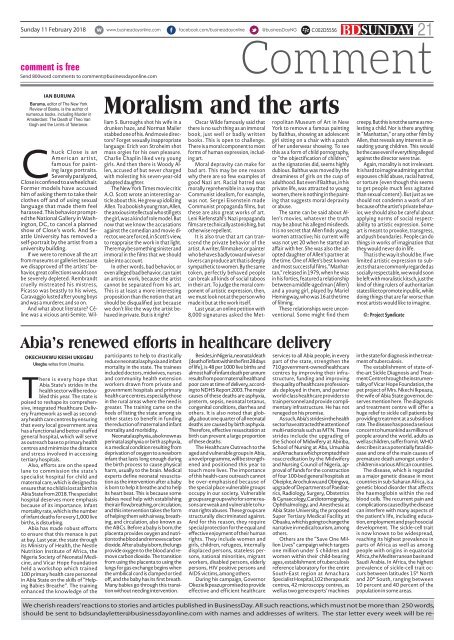BusinessDay 11 Feb 2018
Create successful ePaper yourself
Turn your PDF publications into a flip-book with our unique Google optimized e-Paper software.
Sunday <strong>11</strong> <strong>Feb</strong>ruary <strong>2018</strong><br />
comment is free<br />
Send 800word comments to comment@businessdayonline.com<br />
SUNDAY<br />
BD<br />
21<br />
C002D5556<br />
Comment<br />
IAN BURUMA<br />
Buruma, editor of The New York<br />
Review of Books, is the author of<br />
numerous books, including Murder in<br />
Amsterdam: The Death of Theo Van<br />
Gogh and the Limits of Tolerance.<br />
Chuck Close is an<br />
American artist,<br />
famous for painting<br />
large portraits.<br />
Severely paralyzed,<br />
Close is confined to a wheelchair.<br />
Former models have accused<br />
him of asking them to take their<br />
clothes off and of using sexual<br />
language that made them feel<br />
harassed. This behavior prompted<br />
the National Gallery in Washington,<br />
DC, to cancel a planned<br />
show of Close’s work. And Seattle<br />
University has removed a<br />
self-portrait by the artist from a<br />
university building.<br />
If we were to remove all the art<br />
from museums or galleries because<br />
we disapproved of the artists’ behavior,<br />
great collections would soon<br />
be severely depleted. Rembrandt<br />
cruelly mistreated his mistress,<br />
Picasso was beastly to his wives,<br />
Caravaggio lusted after young boys<br />
and was a murderer, and so on.<br />
And what about literature? Céline<br />
was a vicious anti-Semite. Wil-<br />
Moralism and the arts<br />
liam S. Burroughs shot his wife in a<br />
drunken haze, and Norman Mailer<br />
stabbed one of his. And movie directors?<br />
Forget sexually inappropriate<br />
language: Erich von Stroheim shot<br />
mass orgies for his own pleasure.<br />
Charlie Chaplin liked very young<br />
girls. And then there is Woody Allen,<br />
accused of but never charged<br />
with molesting his seven-year-old<br />
adopted daughter.<br />
The New York Times movie critic<br />
A.O. Scott wrote an interesting article<br />
about this. He grew up idolizing<br />
Allen. To a bookish young man, Allen,<br />
the anxious intellectual who still gets<br />
the girl, was a kind of role model. But<br />
now that we know the accusations<br />
against the comedian and movie director,<br />
we are forced, in Scott’s view,<br />
to reappraise the work in that light.<br />
There may be something sinister and<br />
immoral in the films that we should<br />
take into account.<br />
In other words, bad behavior, or<br />
even alleged bad behavior, can taint<br />
an artistic work, because the artist<br />
cannot be separated from his art.<br />
This is at least a more interesting<br />
proposition than the notion that art<br />
should be disqualified just because<br />
we don’t like the way the artist behaved<br />
in private. But is it right?<br />
Oscar Wilde famously said that<br />
there is no such thing as an immoral<br />
book, just well or badly written<br />
books. This is open to challenge.<br />
There is a moral component to most<br />
forms of human expression, including<br />
art.<br />
Moral depravity can make for<br />
bad art. This may be one reason<br />
why there are so few examples of<br />
good Nazi art. Racial hatred was<br />
morally reprehensible in a way that<br />
Communist idealism, for example,<br />
was not. Sergei Eisenstein made<br />
Communist propaganda films, but<br />
these are also great works of art.<br />
Leni Riefenstahl’s Nazi propaganda<br />
films are technically astonishing, but<br />
otherwise repellent.<br />
It is also true that art can transcend<br />
the private behavior of the<br />
artist. A writer, filmmaker, or painter<br />
who behaves badly toward wives or<br />
lovers can produce art that is deeply<br />
sympathetic to women. By the same<br />
token, perfectly behaved people<br />
can break all kinds of social taboos<br />
in their art. To judge the moral component<br />
of artistic expression, then,<br />
we must look not at the person who<br />
made it but at the work itself.<br />
Last year, an online petition with<br />
8,000 signatures asked the Metropolitan<br />
Museum of Art in New<br />
York to remove a famous painting<br />
by Balthus, showing an adolescent<br />
girl sitting on a chair with a patch<br />
of her underwear showing. To see<br />
this as a form of child pornography,<br />
or “the objectification of children,”<br />
as the signatories did, seems highly<br />
dubious. Balthus was moved by the<br />
dreaminess of girls on the cusp of<br />
adulthood. But even if Balthus, in his<br />
private life, was attracted to young<br />
women, there is nothing in the painting<br />
that suggests moral depravity<br />
or abuse.<br />
The same can be said about Allen’s<br />
movies, whatever the truth<br />
may be about his alleged misdeeds.<br />
It is no secret that Allen finds young<br />
women attractive; his current wife<br />
was not yet 20 when he started an<br />
affair with her. She was also the adopted<br />
daughter of Allen’s partner at<br />
the time. One of Allen’s best known<br />
and most successful films, “Manhattan,”<br />
released in 1979, when he was<br />
in his forties, featured a relationship<br />
between a middle-aged man (Allen)<br />
and a young girl, played by Mariel<br />
Hemingway, who was 16 at the time<br />
of filming.<br />
These relationships were unconventional.<br />
Some might find them<br />
creepy. But this is not the same as molesting<br />
a child. Nor is there anything<br />
in “Manhattan,” or any other film by<br />
Allen, that reveals any interest in assaulting<br />
young children. This would<br />
be the case even if everything alleged<br />
against the director were true.<br />
Again, morality is not irrelevant.<br />
It is hard to imagine admiring art that<br />
espouses child abuse, racial hatred,<br />
or torture (even though this seems<br />
to get people much less agitated<br />
than sexual content). But just as we<br />
should not condemn a work of art<br />
because of the artist’s private behavior,<br />
we should also be careful about<br />
applying norms of social respectability<br />
to artistic expression. Some<br />
art is meant to provoke, transgress,<br />
and push boundaries. People can do<br />
things in works of imagination that<br />
they would never do in life.<br />
That is the way it should be. If we<br />
limited artistic expression to subjects<br />
that are commonly regarded as<br />
socially respectable, we would soon<br />
be left with moralistic kitsch, just the<br />
kind of thing rulers of authoritarian<br />
states like to promote in public, while<br />
doing things that are far worse than<br />
most artists would like to imagine.<br />
©: Project Syndicate<br />
Abia’s renewed efforts in healthcare delivery<br />
OKECHUKWU KESHI UKEGBU<br />
Ukegbu writes from Umuahia.<br />
There is every hope that<br />
Abia State’s strides in the<br />
health sector will be redoubled<br />
this year. The state is<br />
poised to reshape its comprehensive,<br />
integrated Healthcare Delivery<br />
Framework as well as secondary<br />
health care centres by ensuring<br />
that every local government area<br />
has a functional and better-staffed<br />
general hospital, which will serve<br />
as outreach base to primary health<br />
centres and minimize the distance<br />
and stress involved in accessing<br />
tertiary hospitals.<br />
Also, efforts are on the speed<br />
lane to commission the state’s<br />
specialist hospital for child and<br />
maternal care, which is designed to<br />
ensure that no child is lost at birth in<br />
Abia State from <strong>2018</strong>. The specialist<br />
hospital deserves more emphasis<br />
because of its importance. Infant<br />
mortality rate, which is the number<br />
of infant deaths for every 1,000 live<br />
births, is disturbing.<br />
Abia has made robust efforts<br />
to ensure that this menace is put<br />
at bay. Last year, the state through<br />
its Ministry of Health, the Nestle<br />
Nutrition Institute of Africa, the<br />
Nigeria Society of Neonatal Medicine,<br />
and Vicar Hope Foundation<br />
held a workshop which trained<br />
100 primary health care personnel<br />
in Abia State on the skills of “Helping<br />
Babies Breathe”. The training<br />
enhanced the knowledge of the<br />
participants to help to drastically<br />
reduce neonatal asphyxia and infant<br />
mortality in the state. The trainees<br />
included doctors, midwives, nurses<br />
and community health extension<br />
workers drawn from private and<br />
government hospitals and primary<br />
health care centres, especially those<br />
in the rural areas where the need is<br />
greater. The training came on the<br />
heels of listing the state among six<br />
other states to benefit in funding<br />
the reduction of maternal and infant<br />
mortality and morbidity.<br />
Neonatal asphyxia, also known as<br />
perinatal asphyxia or birth asphyxia,<br />
is a medical condition resulting from<br />
deprivation of oxygen to a newborn<br />
infant that lasts long enough during<br />
the birth process to cause physical<br />
harm, usually to the brain. Medical<br />
experts define neonatal resuscitation<br />
as the intervention after a baby<br />
is born to help it breathe and to help<br />
its heart beat. This is because some<br />
babies need help with establishing<br />
their air flow, breathing, or circulation,<br />
and this intervention takes the form<br />
of helping them with airway, breathing,<br />
and circulation, also known as<br />
the ABCs. Before a baby is born, the<br />
placenta provides oxygen and nutrition<br />
to the blood and removes carbon<br />
dioxide. After a baby is born, the lungs<br />
provide oxygen to the blood and remove<br />
carbon dioxide. The transition<br />
from using the placenta to using the<br />
lungs for gas exchange begins when<br />
the umbilical cord is clamped or tied<br />
off, and the baby has its first breath.<br />
Many babies go through this transition<br />
without needing intervention.<br />
Besides, in Nigeria, neonatal death<br />
(death of infant within the first 28 days<br />
of life), is 48 per 1000 live births and<br />
almost half of infant death per annum<br />
results from poor maternal health and<br />
poor care at time of delivery, according<br />
to NDHS Report 2003. The major<br />
causes of these deaths are asphyxia,<br />
preterm, sepsis, neonatal tetanus,<br />
congenital conditions, diarrhea and<br />
others. It is also noted that globally,<br />
about one quarter of all neonatal<br />
deaths are caused by birth asphyxia.<br />
Therefore, effective resuscitation at<br />
birth can prevent a large proportion<br />
of these deaths.<br />
The Healthcare Outreach to the<br />
aged and vulnerable groups in Abia,<br />
a novel programme, will be strengthened<br />
and positioned this year to<br />
touch more lives. The importance<br />
of this health-care outreach cannot<br />
be over-emphasised because of<br />
the special place vulnerable groups<br />
occupy in our society. Vulnerable<br />
groups are groups who for some reasons<br />
are weak and vulnerable to human<br />
rights abuses. These groups are<br />
structurally discriminated against.<br />
And for this reason, they require<br />
special protection for the equal and<br />
effective enjoyment of their human<br />
rights. They include women and<br />
girls, children, refugees, internally<br />
displaced persons, stateless persons,<br />
national minorities, migrant<br />
workers, disabled persons, elderly<br />
persons, HIV positive persons and<br />
AIDS victims, among others.<br />
During his campaign, Governor<br />
Okezie Ikpeazu promised to provide<br />
effective and efficient healthcare<br />
services to all Abia people, in every<br />
part of the state, strengthen the<br />
710 government-owned healthcare<br />
centres by improving their infrastructure,<br />
funding and improving<br />
the quality of healthcare professionals<br />
deployed in them, and partner<br />
world-class healthcare providers to<br />
train personnel and provide complimentary<br />
infrastructure. He has not<br />
reneged on his promise.<br />
As such, Abia’s strides in the health<br />
sector have attracted the attention of<br />
multi-nationals such as MTN. These<br />
strides include the upgrading of<br />
the School of Midwifery at Abiriba,<br />
School of Nursing at Aba, Umuahia<br />
and Amachara which prompted their<br />
reaccreditation by the Midwifery<br />
and Nursing Council of Nigeria, approval<br />
of funds for the construction<br />
of four 100-bed general hospitals at<br />
Okeipke, Arochukwu and Obingwa,<br />
upgrade of Departments of Paediatrics,<br />
Radiology, Surgery, Obstetrics<br />
& Gynaecology, Cardiotomography,<br />
Ophthalmology, and Anesthesia at<br />
Abia State University, the proposed<br />
Super Tertiary Medical Facility at<br />
Obuaku, which is going to change the<br />
narrative in medical tourism, among<br />
others.<br />
Others are the “Save One Million<br />
Lives” campaign which targets<br />
one million under 5 children and<br />
women within their child-bearing<br />
ages, establishment of tuberculosis<br />
reference laboratory for the entire<br />
South-East region at Amachara<br />
Specialist Hospital, 102 therapeutic<br />
centres, 42 microscopy centres, as<br />
well as two gene experts’ machines<br />
in the state for diagnosis in the treatment<br />
of tuberculosis.<br />
The establishment of state-ofthe-art<br />
Sickle Diagnosis and Treatment<br />
Centre through the instrumentality<br />
of Vicar Hope Foundation, the<br />
pet project of Mrs. Nkechi Ikpeazu,<br />
the wife of Abia State governor, deserves<br />
mention here. The diagnosis<br />
and treatment centre will offer a<br />
huge relief to sickle cell patients by<br />
providing treatment at a subsidised<br />
rate. The disease has posed a serious<br />
concern to humankind as millions of<br />
people around the world, adults as<br />
well as children, suffer from it. WHO<br />
describes it as a potentially fatal disease<br />
and one of the main causes of<br />
premature death amongst under-5<br />
children in various African countries.<br />
The disease, which is regarded<br />
as a major genetic disease in most<br />
countries in sub-Saharan Africa, is a<br />
genetic blood disorder that affects<br />
the haemoglobin within the red<br />
blood cells. The recurrent pain and<br />
complications caused by the disease<br />
can interfere with many aspects of<br />
the patient’s life, including education,<br />
employment and psychosocial<br />
development. The sickle-cell trait<br />
is now known to be widespread,<br />
reaching its highest prevalence in<br />
parts of Africa as well as among<br />
people with origins in equatorial<br />
Africa, the Mediterranean basin and<br />
Saudi Arabia. In Africa, the highest<br />
prevalence of sickle-cell trait occurs<br />
between latitudes 15° North<br />
and 20° South, ranging between<br />
10 percent and 40 percent of the<br />
population in some areas.<br />
We cherish readers’ reactions to stories and articles published in <strong>BusinessDay</strong>. All such reactions, which must not be more than 250 words,<br />
should be sent to bdsundayletter@businessdayonline.com with names and addresses of writers. The star letter every week will be re-


















